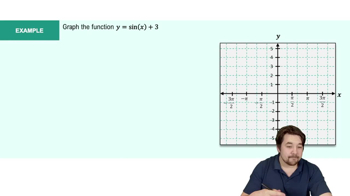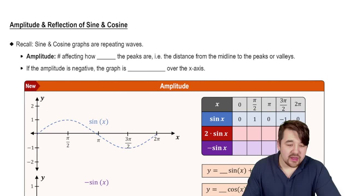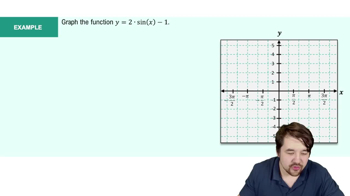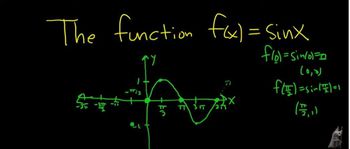Table of contents
- 0. Review of College Algebra4h 43m
- 1. Measuring Angles39m
- 2. Trigonometric Functions on Right Triangles2h 5m
- 3. Unit Circle1h 19m
- 4. Graphing Trigonometric Functions1h 19m
- 5. Inverse Trigonometric Functions and Basic Trigonometric Equations1h 41m
- 6. Trigonometric Identities and More Equations2h 34m
- 7. Non-Right Triangles1h 38m
- 8. Vectors2h 25m
- 9. Polar Equations2h 5m
- 10. Parametric Equations1h 6m
- 11. Graphing Complex Numbers1h 7m
4. Graphing Trigonometric Functions
Graphs of the Sine and Cosine Functions
Problem 4.55
Textbook Question
Graph each function over a two-period interval.
y = 1 - 2 cos ((1/2)x)
 Verified step by step guidance
Verified step by step guidance1
Identify the basic form of the cosine function: The given function is \( y = 1 - 2 \cos\left(\frac{1}{2}x\right) \). This is a transformation of the basic cosine function \( y = \cos(x) \).
Determine the amplitude: The amplitude is the coefficient of the cosine function, which is 2. This means the graph will oscillate 2 units above and below the midline.
Find the period: The period of a cosine function \( y = \cos(bx) \) is given by \( \frac{2\pi}{b} \). Here, \( b = \frac{1}{2} \), so the period is \( 2\pi \times 2 = 4\pi \).
Identify the vertical shift: The function has a vertical shift of 1 unit upwards, as indicated by the '+1' outside the cosine function.
Graph the function over two periods: Start by plotting the midline at \( y = 1 \). Then, plot the maximum and minimum points at \( y = 3 \) and \( y = -1 \) respectively, over the interval \( 0 \) to \( 8\pi \), which covers two periods of \( 4\pi \).
Recommended similar problem, with video answer:
 Verified Solution
Verified SolutionThis video solution was recommended by our tutors as helpful for the problem above
Video duration:
0m:0sPlay a video:
Was this helpful?
Key Concepts
Here are the essential concepts you must grasp in order to answer the question correctly.
Cosine Function
The cosine function is a fundamental trigonometric function that describes the relationship between the angle and the adjacent side over the hypotenuse in a right triangle. It is periodic, with a standard period of 2π, meaning it repeats its values every 2π radians. Understanding the properties of the cosine function, including its amplitude, period, and phase shift, is essential for graphing transformations of the function.
Recommended video:

Graph of Sine and Cosine Function
Amplitude and Period
Amplitude refers to the maximum distance from the midline of a trigonometric function to its peak or trough. In the function y = 1 - 2 cos((1/2)x), the amplitude is 2, indicating the function oscillates 2 units above and below its midline. The period, determined by the coefficient of x, is calculated as 2π divided by the coefficient, resulting in a period of 4π for this function, which affects how frequently the graph repeats.
Recommended video:

Period of Sine and Cosine Functions
Graphing Transformations
Graphing transformations involve modifying the basic shape of a function through shifts, stretches, and reflections. In the given function, y = 1 - 2 cos((1/2)x), the '1' indicates a vertical shift upward by 1 unit, while the negative sign before the cosine indicates a reflection across the midline. Understanding these transformations is crucial for accurately sketching the graph over the specified interval.
Recommended video:

Introduction to Transformations

 5:53m
5:53mWatch next
Master Graph of Sine and Cosine Function with a bite sized video explanation from Nick Kaneko
Start learningRelated Videos
Related Practice
















